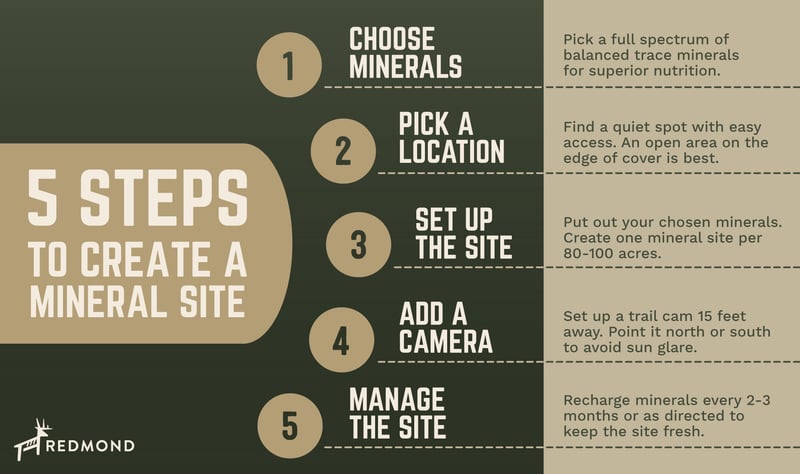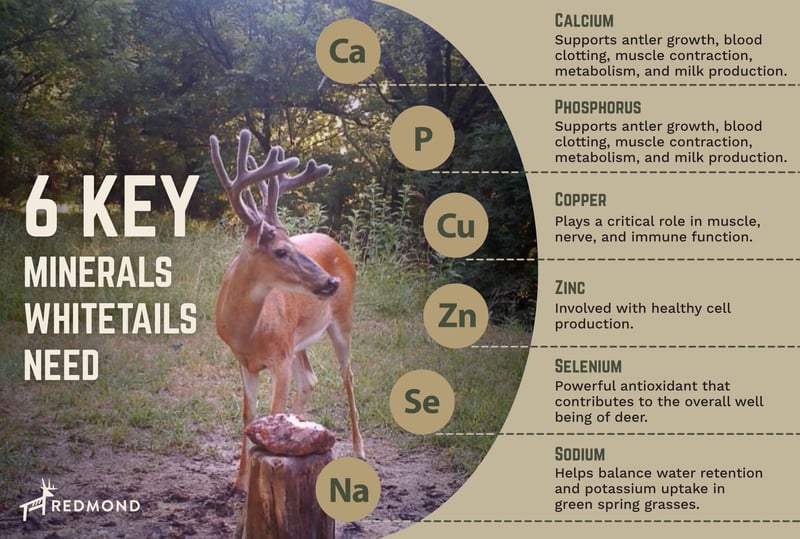Redmond Hunt Blog
Minerals and Supplements for Deer Herd Management
Redmond Hunt March 15, 2022
Deer minerals support better hunting and herd management. Find out which trace minerals deer need and how to supplement them on your private lands.
As passionate hunters and dedicated conservationists, we aim to cultivate an environment on our lands where whitetails come, thrive, and stay. But if deer don't find the right habitat and nutrients they need on our properties, they’ll inevitably leave and find them somewhere else.
So how do we foster healthy habitats on our lands and better manage deer herds? Small changes in the environment can have a huge impact. Besides diverse forage, water, and cover, supplementing trace minerals is one great way to improve habitat and achieve healthier deer herds.
In this article, we'll discuss herd nutrition, focusing specifically on the role of minerals, why they're important and the best ways to supplement them.
Basics of Herd Nutrition
Wildlife depend on the land to provide the nutrients they need. Unlike humans, they can’t pound a protein shake or pop a multivitamin to fill in gaps from scarce forage or inferior browse. That's why it's important to help foster a year-round environment where herds not only survive but thrive with consistent, high-quality nutrition.
The University of Missouri notes good nutrition, age, and genetics are the three main factors that contribute to higher recruitment rates, greater body mass, and bigger antler growth in whitetail deer. Breaking down the essentials of good nutrition are these five requirements: protein, energy, water, vitamins, and minerals. Let's dive further into the role of minerals in this equation.
Why Do Deer Need Minerals?
The total mineral content in a deer’s body is only about 5 percent. Not much, right? So are they that important? Absolutely. Wildlife may have access to plenty of feed and still not thrive if the right minerals aren’t present. Whitetails' needs and demand for minerals also change throughout the year and during various life phases. Here are some critical physiological functions minerals assist with:
- Body growth
- Antler growth
- Immune health
- Fetal growth
- Milk production
- Reproduction
- Digestion
What Minerals Do Deer Need?
Minerals are classified as either macro- or micronutrients. These classifications indicate whether deer need a little (micro) or a lot (macro). Some important macronutrients include: calcium (Ca), phosphorus (P), potassium (K), magnesium (Mg), sodium (Na), and sulfur (S). Micronutrients include: iron (Fe), copper (Cu), Zinc (Zn), manganese (Mn), cobalt (Co), iodine (I), and selenium (Se). While ongoing research is needed to determine the exact mineral needs and quantities for whitetail deer, whildlife experts know the minerals listed below play important roles.
Calcium and Phosphorous
The two most abundant and studied macronutrients in whitetails are calcium and phosphorus. These minerals are critical for deer antler growth. The University of Missouri notes almost 90 percent of calcium and phosphorous in a deer’s body goes to the skeletal system. During spring, bucks draw off this abundant store in their bones to grow antlers. After antlers harden, the minerals missing in the bones are replaced through diet. Calcium and phosphorous also play a crucial role in blood clotting, muscle contraction, general metabolism, and milk production in does.
Copper, Zinc, and Selenium
Zinc, copper, and selenium are three vital micronutrients. Copper plays a critical role in muscle, nerve, and immune function, while Zinc is involved with healthy cell production. Selenium is a powerful antioxidant that contributes to the overall wellbeing of deer.
Sodium
Deer need sodium—and seem to crave it—especially during spring and summer. Additional salt is necessary for deer to replenish sodium levels from increased water and potassium uptake in green spring grasses.
Supplementing Trace Minerals for Deer
Deer in the wild seek minerals from plants, soil, water, and natural salt licks. But what if the soil or forage on your land is lacking or deficient in trace minerals? You may find herd numbers diminishing as deer relocate to your neighbor’s acres.
Consider starting a mineral supplemention program to elevate your herd management and increase deer populations. There are two ways to supplement trace minerals for your deer and land.
- Improve soil in food plots. While all soils contain trace minerals, deficiencies can be widespread. An effective deer nutritional strategy involves improving the soils on your land—especially in and around food plots. Begin my testing your soil's mineral content, then introduce soil amendments to restore mineral balance.
- Provide mineral sites. The most cost-effective way to provide trace minerals is to establish mineral sites that are stocked year-round. It’s a simple and affordable practice to give deer acces to the essential minerals they require. Follow the five steps below, or learn how to create a mineral site in this blog.
 Get Balanced Minerals with Trophy Rock
Get Balanced Minerals with Trophy Rock
Supplementing minerals is just one part of a good herd management plan, but an important one. At Redmond, we have your deer mineral needs covered! All Trophy Rock products are natural, mined sea salt supplements with a full spectrum of balanced trace minerals that encourage optimum health and antler growth. Click below to purchase Redmond products and begin improving your herd population and hunting experience today.
© Redmond Hunt 2023. All rights reserved.




.jpg)
